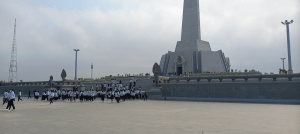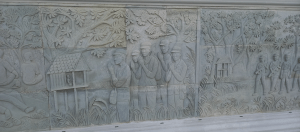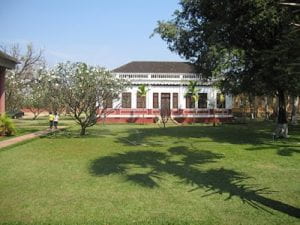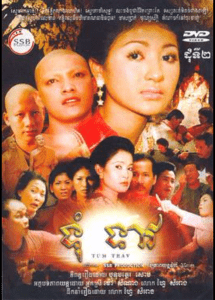Summary of Events
Since we did not have designated students bloggers writing for these last few travel days, I’d like to add a few words on January 17, 18 and 19.
On January 17, we left Phnom Penh, the capital of Cambodia. After three intensive days in the capital, our bus was headed back to Siem Reap to wrap up the course.
Our bus exited the capital passing by the Royal Palace once again, and also the small hill that gave the name to the city: The Phnom (hill) of Penh, the lady said to have rescued several Buddha statues from a tree floating in the river below, and installing them in a new temple on the hill.
We then drove through the city’s northern outskirts, passing major sand mining projects along on Highway 5, supporting the construction under way in the capital and in many parts of Cambodia. Our final stop in the capital was the Win-Win Memorial monument just north of Phnom Penh. This giant monument had been suggested as a stop en route, by our colleagues at the Center for Khmer Studies in Siem Reap. It was opened only recently, and was clearly built in praise of the policies of current and longstanding Prime Minister Hun Sen, who has long dominated Cambodian politics. A local guide explained the concept of Win-Win as Hun Sen’s policies for peace and reconstruction. We arrived just as a large group of high school students was taking photos and selfies on the steps of the monument.

The monument’s base is decorated with fascinating stone reliefs offers startling parallels to the reliefs of Angkor and their praise for the ancient kings. The reliefs tells the personal story of Prime Minister Hun Sen in the context of Cambodia’s recent history: how he broke with Pol Pot’s Khmer Rouge and defeated them with the help of Vietnam, which in 1979 sent its army into Cambodia to overturn Pol Pot’s regime, and then withdrew to make way for the 1993 election organized through the United Nations Transitional Authority for Cambodia, through which the country’s independence was finally restored.
Given how Pol Pot’s KR regime hated educated people, and glasses became a sign of someone belonging to the wrong class, it was striking how the stone reliefs feature a Hun Sen wearing glasses! The reliefs feature how he, for example, worshipped a local spirit’s shrine, in contrast to Pol Pot who sought to abolish all religion:

They also include thought bubbles, themselves also carved in stone — for example, spelling out the story of how Hun Sen regretted Pol Pot’s mass killings, depicted in their own thought bubble:

The monument also includes a collection of miniature replicas of some of the most important Angkor structures, such as the Bayon. In short, the Win-Win memorial is a deeply political new monument which presents a contemporary interpretation of Cambodia’s recent history, and consciously does so in the architectural language of Cambodia’s ancient kings —it is even protected by the same mythic Naga snakes that protect the ancient temples of Angkor. It’s all worth deeper study.
Back on the bus, we shifted back to our Highway 6, which would take us back to Sieam Reap. Many of us were clearly tired, and took the chance to nap on the bus. We halted only at the famous stop called Prey Rous, for lunch at a lakeside restaurant. The weather turned very sunny and hot — more like the season, than the few anomalous days with light rain, which we had earlier. At the end of the day, we arrived back at our new Siem Reap hotel, the Royal Crown, also within walking distance from the CKS.
On January 18, the last day of the course, there was no official program in the morning. Some students took the opportunity to make a last excursion on their own (such as, to see the retired elephants in Kulen Forest), but many said they spent the day in Siem Reap coffee shops, wrapping up the short papers I had asked them to write — which gave me a bad conscience. I had hoped they could be written during the past weeks …

 The film was Tum and Teav — the tragi-comic (in the end, mostly tragic) 2003 remake of the famous story of a pretty girl pursued by three different men of different social standing, in an unbelievable drama playing out in the time of an unspecified “good old days” of kings and river boats. The film was a smashing success in its own time.
The film was Tum and Teav — the tragi-comic (in the end, mostly tragic) 2003 remake of the famous story of a pretty girl pursued by three different men of different social standing, in an unbelievable drama playing out in the time of an unspecified “good old days” of kings and river boats. The film was a smashing success in its own time.
At 7:15pm we gathered for a farewell dinner at the Sokkhak River Restaurant, next to Chanrey Tree, run by the same company. The restaurants serve high-end Cambodian cuisine. At one juncture, I expressed our thanks to the CKS staff, who also joined the dinner and who did so much to make the course a success; as well as to my indispensable TA, Brian Sengdala, and also to all our students, who not only did such good work but also kept us all in high spirits throughout!
On January 19, most of us left Cambodia from Siem Reap’s airport. Mr. Peng from the CKS drove us, in three round trips, divided by flight departure.
It was all too short!
Magnus Fiskesjö